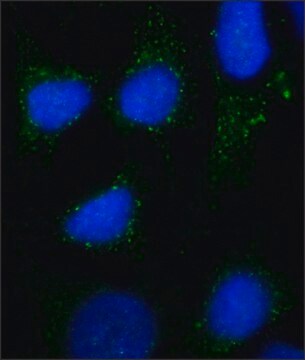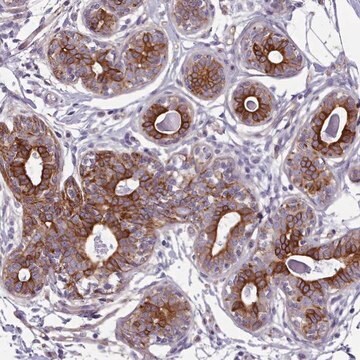MABT837
Anti-LBPA Antibody, clone 6C4
clone 6C4, from mouse
Synonim(y):
LBPA
About This Item
Polecane produkty
pochodzenie biologiczne
mouse
Poziom jakości
forma przeciwciała
purified immunoglobulin
rodzaj przeciwciała
primary antibodies
klon
6C4, monoclonal
reaktywność gatunkowa (przewidywana na podstawie homologii)
all
metody
ELISA: suitable
dot blot: suitable
electron microscopy: suitable
immunocytochemistry: suitable
izotyp
IgG1κ
Warunki transportu
wet ice
docelowa modyfikacja potranslacyjna
unmodified
informacje o genach
bacterial ... Lbpa(61281717)
Opis ogólny
Specyficzność
Immunogen
Zastosowanie
Immunocytochemistry Analysis: A representative lot detected late endosome LBPA immunoreactivity by fluorescent immunocytochemistry using MLN64-overexpressing MCF7 cells (Alpy, F., et al. (2001). J Biol Chem. 276(6):4261-4269).
Immunocytochemistry Analysis: A representative lot detected late endosome LBPA immunoreactivity in skin fibroblasts from healthy donors, as well as Niemann–Pick type C (NPC) and Tay-Sachs disease patients by fluorescent immunocytochemistry (Kobayahsi, T., et al. (1999). Nat Cell Biol. 1(2):113-118).
Immunocytochemistry Analysis: A representative lot detected late endosome LBPA immunoreactivity in baby hamster kidney (BHK) cells by fluorescent immunocytochemistry (Kobayahsi, T., et al. (1998). Nature. 392(6672):193-197).
Electron Microscopy Analysis: A representative lot detected similar cellular LBPA distribution in the skin fibroblasts from autosomal recessive Niemann–Pick type C disease (NPC) patients as seen in baby hamster kidney (BHK) cells (Kobayahsi, T., et al. (1999). Nat Cell Biol. 1(2):113-118).
Electron Microscopy Analysis: A representative lot detected LBPA immunoreactivity specifically associated with the late endosomes in baby hamster kidney (BHK) cells, but not the lgp120-positive limiting membranes of the same endosomes (Kobayahsi, T., et al. (1998). Nature. 392(6672):193-197).
ELISA Analysis: A representative lot specifically detected wells coated with total baby hamster kidney (BHK) cell lipid extract or purified LBPA, but not other lipids (PC, PE, SM, PS, CL, or PI) purified BHK lipid extract (Kobayahsi, T., et al. (1998). Nature. 392(6672):193-197)
Dot Blot Analysis: A representative lot specifically detected purified LBPA spotted on a HPTLC plate, but not other lipids (PC, PE, SM, PS, CL, PI, Sul, Chol, Cer, CE) purified from baby hamster kidney (BHK) cell lipid extract (Kobayahsi, T., et al. (1998). Nature. 392(6672):193-197).
Cell Structure
Adhesion (CAMs)
Jakość
Immunocytochemistry Analysis: 4.0 µg/mL of this antibody stained late endosomes in HeLa cells.
Postać fizyczna
Przechowywanie i stabilność
Inne uwagi
Oświadczenie o zrzeczeniu się odpowiedzialności
Nie możesz znaleźć właściwego produktu?
Wypróbuj nasz Narzędzie selektora produktów.
Kod klasy składowania
12 - Non Combustible Liquids
Klasa zagrożenia wodnego (WGK)
WGK 1
Temperatura zapłonu (°F)
Not applicable
Temperatura zapłonu (°C)
Not applicable
Certyfikaty analizy (CoA)
Poszukaj Certyfikaty analizy (CoA), wpisując numer partii/serii produktów. Numery serii i partii można znaleźć na etykiecie produktu po słowach „seria” lub „partia”.
Masz już ten produkt?
Dokumenty związane z niedawno zakupionymi produktami zostały zamieszczone w Bibliotece dokumentów.
Nasz zespół naukowców ma doświadczenie we wszystkich obszarach badań, w tym w naukach przyrodniczych, materiałoznawstwie, syntezie chemicznej, chromatografii, analityce i wielu innych dziedzinach.
Skontaktuj się z zespołem ds. pomocy technicznej








